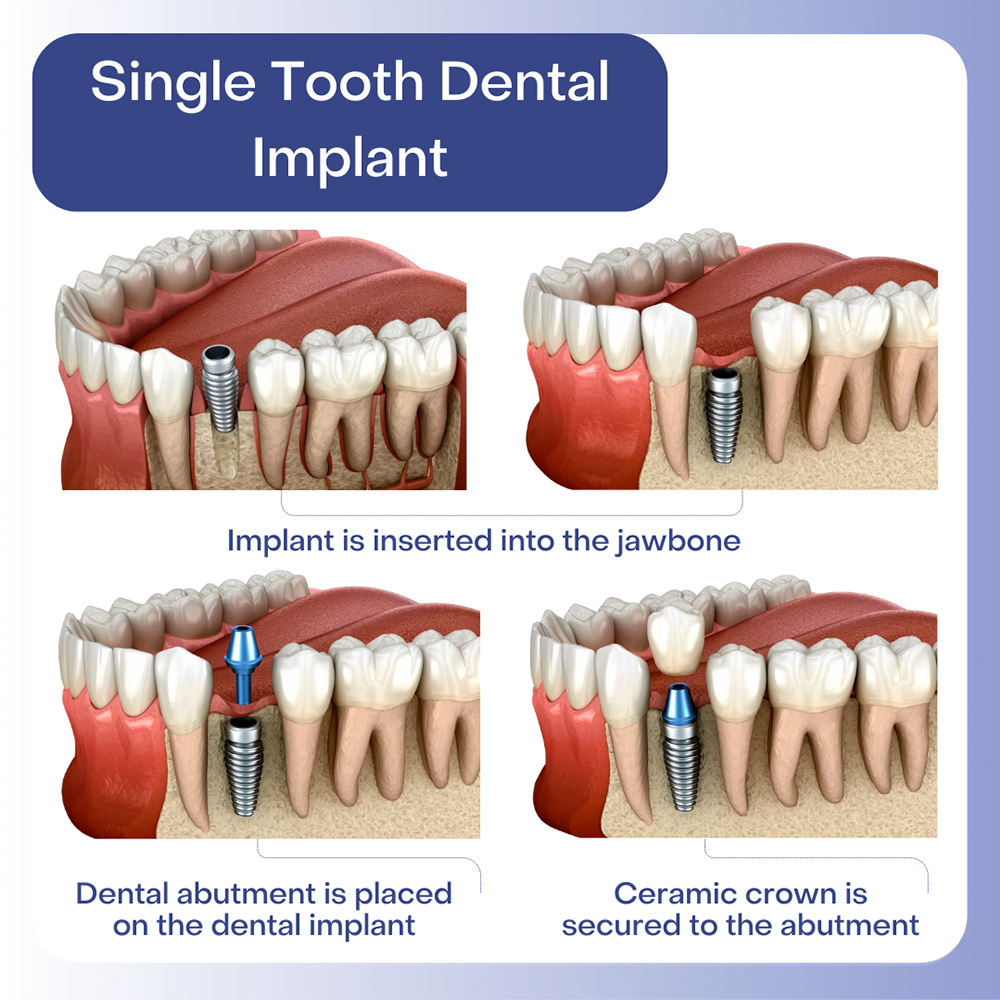The Buzz on Dental Sense
The Buzz on Dental Sense
Blog Article
The Only Guide to Dental Sense
Table of ContentsIndicators on Dental Sense You Need To KnowThe Best Guide To Dental SenseExcitement About Dental SenseNot known Details About Dental Sense
are medical tools operatively implanted into the jaw to bring back an individual's capability to eat or their look. They give assistance for synthetic (fake) teeth, such as crowns, bridges, or dentures. When a tooth is lost because of injury or illness, a person can experience complications such as quick bone loss, malfunctioning speech, or changes to chewing patterns that cause discomfort.Dental dental implant systems consist of a dental implant body and oral implant joint and may also include a joint addiction screw. Cosmetic dentistry services. The dental implant body is operatively inserted in the jawbone instead of the tooth's origin. The oral implant abutment is typically connected to the dental implant body by the joint fixation screw and expands with gums right into the mouth to support the affixed man-made teeth
(https://dentalsense1.weebly.com/)Structure of The Dental Implant System selecting dental implants, speak to your dental company regarding the potential benefits and threats, and whether you are a prospect for the treatment. Points to consider: Your total health is an important element in identifying whether you are a good candidate for dental implants, how long it will certainly require to heal, and how much time the implant may remain in area.
Smoking may impact the healing process and decrease the long-lasting success of the dental implant. The healing process for the dental implant body may take several months or longer, throughout which time you commonly have a short-lived joint in area of the tooth. the oral implant procedure: Carefully follow the dental health directions provided to you by your dental provider.
Dental Sense Things To Know Before You Get This
Implant failure can lead to the demand for another procedure to repair or change the dental implant system. Brings back the capacity to chew Recovers cosmetic appearance Aids keep the jawbone from diminishing as a result of bone loss Maintains the health of the bordering bone and periodontals Assists maintain nearby (neighboring) teeth stable Boosts lifestyle Damages to surrounding all-natural teeth throughout implant positioning Injury to the surrounding cells during surgical procedure, such as sinus perforation Injury during surgical treatment (for instance, fracture of surrounding jawbone) Insufficient feature, such as really feeling like the teeth do not attack together typically An experience that the tooth hangs or twisting in position resulting from an abutment screw loosening Implant body failure (looseness of the dental implant body) due to systemic infection, which may be much more most likely in people with unchecked diabetes as a result of neighborhood infection in bone and gum tissues sustaining the dental implant body due to delayed recovery, which may be more probable in individuals that smoke Problem cleaning up the gums around the implant, resulting in inadequate dental health Unattended gum condition Post-surgical numbness due to nerve impingement or damage Constantly notify health care companies and imaging service technicians that you have dental implants prior to any type of magnetic resonance imaging (MRI) or x-ray procedures.
FDA is not knowledgeable about any kind of damaging occasions reported for MRI or x-ray procedures with dental implants. Dental implants systems are generally made from materials that adhere to worldwide agreement standards of the International Organization for Standardization (ISO) or ASTM International. These criteria have information of what makes a safe material.

A dental implant is a structure that replaces a missing out on tooth. With screw-like tools, the cosmetic surgeon inserts a dental implant right into the jawbone, and it functions as a support for a fabricated tooth, called a crown. A device called an abutment attaches the fabricated tooth to the dental implant. The crown is customized to fit the individual's mouth and match the shade of their teeth.
The Buzz on Dental Sense
Some individuals are not qualified for oral implant surgical procedure. It is for oral doctors to operate individuals with: intense illnessuncontrollable metabolic diseasebone or soft cells illness or infectionIf these problems are solved, an individual can have the surgery. In, dental specialists avoid from operating individuals with: If individuals with any one of the above undertake oral implant surgery, there is a greater threat of the dental implant stopping working.

Dental dental implant surgical procedure is a customized procedure. Give you time to recover. Affix the message More hints and last crown, bridge or denture.
Next off, your doctor will thoroughly put the dental implant into your jaw. Ultimately, your doctor will certainly rearrange your gums and close the incision with stitches. If your dental implant is near the front of your mouth, your dentist will certainly make a momentary tooth for you to put on till you recover. By doing this, you will not have a gap in your smile while you recover.
Getting The Dental Sense To Work
Your service provider can inform you what to anticipate in your scenario. Throughout the healing stage, your jawbone must fuse to the dental implant. This procedure, called osseointegration, is essential for stability and lasting success. This process can take anywhere from 3 to nine months. In some situations, it might take longer.
As soon as your implant heals, your dentist can attach the joint (tiny port blog post) and your final restoration (crown, bridge or denture). This typically takes about one hour to complete and may need a 2nd small surgical treatment. You should not feel any discomfort during your oral implant procedure due to the fact that your service provider will certainly make use of medicine to numb your gum tissues.
Report this page